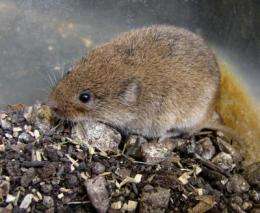'Hidden' differences of chromosome organization become visible

Why different species have dissimilar sets of chromosomes? Why the differentiated species often conserve apparently identical chromosome complements? Furthermore, why, while chromosome rearrangements can considerably change the course of species evolution, certain variation among individuals and populations of some species persists indefinitely? Such questions motivate researchers to compare chromosomes in closely related species.
To understand the nature of chromosome changes in the voles Microtus savii, researchers from the Rome State University "Sapienza" launched a molecular cytogenetic study. Three of the five Italian forms of pine voles showed remarkable differences in chromosomal distribution of two molecular markers. Analyzing these data and weighing them against previously obtained genetic information, the authors expect to improve the taxonomy of these rodents and to track the pathway of their chromosomal evolution.
The Italian pine voles have long been known as a "species complex", namely the Microtus savii complex. The group includes five "forms": "savii", "brachycercus", "nebrodensis", "niethammericus", and "tolfetanus", distributed throughout the Apennine peninsula. The most widely dispersed is "savii"; "brachycercus" lives in Calabria, "niethammericus" inhabits the Southeast part of the peninsula, while "nebrodensis" is restricted to Sicily.
These ground voles have evolved at different times either with or without chromosomal rearrangements. Chromosomal distribution of specific genes and DNA sequences can help to distinguish between related species with very similar, apparently identical, chromosomes. By localization of such molecular "markers" on chromosomes, or so-called "physical mapping", researchers evidence differences that are normally invisible in microscope. These differences indicate "hidden" processes of chromosome diversification.
More information: Gornung E, Bezerra AMR, Castiglia R (2011) Comparative chromosome mapping of the rRNA genes and telomeric repeats in three Italian pine voles of the Microtus savii s.l. complex (Rodentia, Cricetidae). Comparative Cytogenetics 5(3): 247. doi: 10.3897/CompCytogen.v5i3.1429
Provided by Pensoft Publishers















